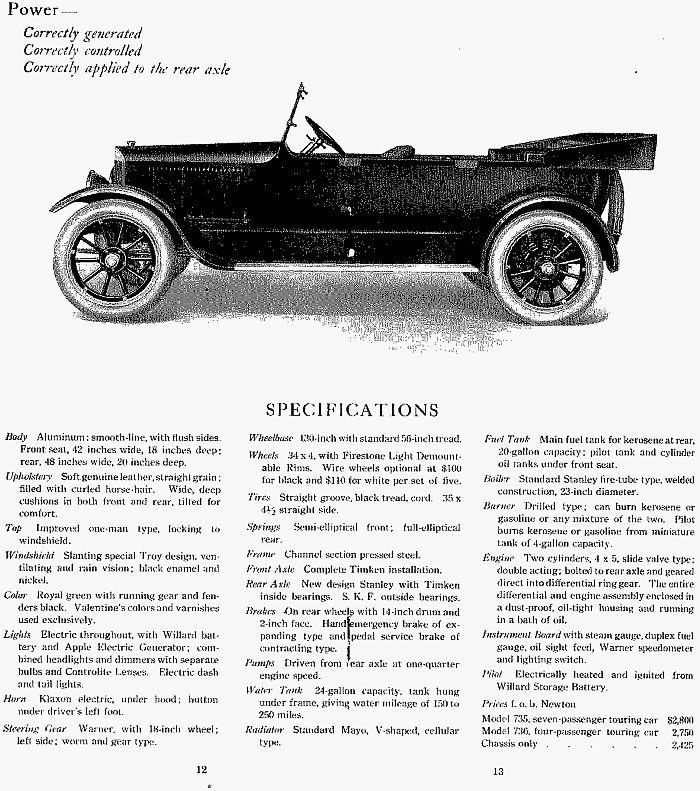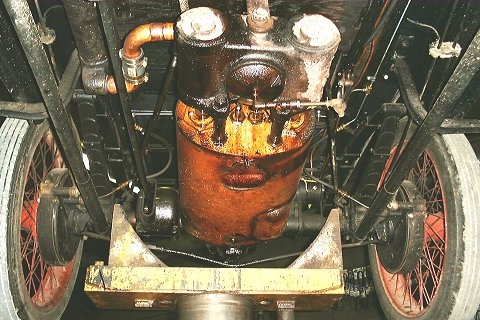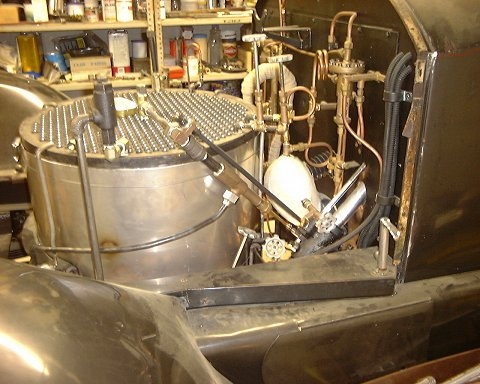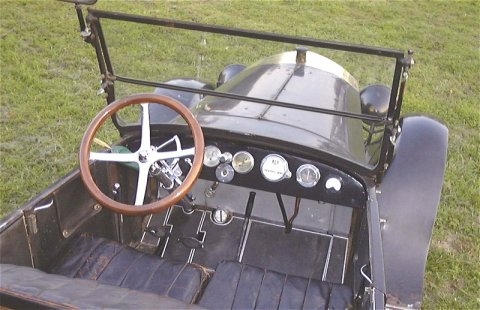

Interested in some of the technical details regarding the Stanley Steamer for the layman? The following is a computer scan of the two center pages from a Stanley Motor Carriage Company sales brochure detailing the specifications for the Model 735, 7-passenger touring car.

"Power,
Correctly generated,
Correctly controlled,
Correctly applied to the rear axle."
This slogan appeared in many of the ads for Stanley Motor Carriages. It truly represents the design philosophy that the Stanley twins applied to their cars. Steam cars unitize an external combustion (Rankine cycle) engine where the fuel source is consumed external to the engine. A steam boiler generates vast quantities of power for later use on demand unlike the internal combustion (Otto cycle) engine that must develop the needed power on demand. A Stanley steam engine provides four power impulses per crankshaft rotation similar to an 8-cylinder internal combustion engine. However, the power is applied uniformly for a longer length of the stroke than the hammer-like explosions common to gasoline or diesel engines. This provides the steam engine an advantage of more torque in a smaller package over what can be generated with a gasoline engine of equivalent rating.
 Early Stanleys were fueled with gasoline but later models incorporated a two-fuel system of gasoline for the pilot and kerosene for the main burner. Kerosene, provided not only more heat energy per unit than gasoline,
it was also safer and less expensive. Both the Stanley pilot that operates continuously as well as the main burner which operates on steam demand is based on the simple principles of the Bunsen Burner. In the Stanley the heat of the fire vaporizes the liquid fuel before the fuel vapor is fed through an orifice, mixed with air, and burned below the boiler. To start a Stanley a torch is used to preheat the vaporizing tube and light the pilot making the Stanley Steamer one of the few cars difficult to steal in anything less than 20 minutes. Fuel efficiency was roughly 10-12 miles to the gallon.
Early Stanleys were fueled with gasoline but later models incorporated a two-fuel system of gasoline for the pilot and kerosene for the main burner. Kerosene, provided not only more heat energy per unit than gasoline,
it was also safer and less expensive. Both the Stanley pilot that operates continuously as well as the main burner which operates on steam demand is based on the simple principles of the Bunsen Burner. In the Stanley the heat of the fire vaporizes the liquid fuel before the fuel vapor is fed through an orifice, mixed with air, and burned below the boiler. To start a Stanley a torch is used to preheat the vaporizing tube and light the pilot making the Stanley Steamer one of the few cars difficult to steal in anything less than 20 minutes. Fuel efficiency was roughly 10-12 miles to the gallon.
Stanley steamers generate steam in drum shaped boilers ranging from 14" to 30" in diameter and from 14" to 18" in height. Similar to a battery the Stanley boiler stores steam energy for later use on demand. Unique in their design, no Stanley boiler has ever been documented to explode. The circular boiler walls are strengthened with three layers of exceptionally strong piano wire to provide sidewall strength unequalled in boiler designs for similar ratings. The use of between 500 and 1,000 fire tubes not only efficiently transfers heat to the water, they provide a structural strength to the boiler ends. Operated nominally at 600 PSIG, boilers were factory tested to twice operating pressure before being placed in a car.
 Once generated, steam is released from the boiler through a driver controlled throttling valve. The steam is routed to the engine after making a final pass through the burner fire to absorb 150-degrees
or so of additional superheat energy. Upon reaching the engine the steam is directed through D slide valves to one of the double-acting, dual cylinders.
Stanley Motor Carriages, while rated in boiler steaming capacities of 10, 20, and 30 horsepower, had engines capable of developing 100 horsepower and more for short periods of time. The engine was mounted to the rear drive axle at a
nominal 1.5:1 gear ratio between the crankshaft and the differential gear. Transmissions were not required and hence there was no "neutral" or clutch.
Once generated, steam is released from the boiler through a driver controlled throttling valve. The steam is routed to the engine after making a final pass through the burner fire to absorb 150-degrees
or so of additional superheat energy. Upon reaching the engine the steam is directed through D slide valves to one of the double-acting, dual cylinders.
Stanley Motor Carriages, while rated in boiler steaming capacities of 10, 20, and 30 horsepower, had engines capable of developing 100 horsepower and more for short periods of time. The engine was mounted to the rear drive axle at a
nominal 1.5:1 gear ratio between the crankshaft and the differential gear. Transmissions were not required and hence there was no "neutral" or clutch.
Using ball-bearing construction throughout, the Stanley car was capable of speeds in excess of 75 MPH for short periods of time if one could locate a dirt road of the period suitable for the exercise. Exhaust steam from the engine is first used to preheat the water supply to the boiler further improving operating efficiency. On early cars the spent steam exited the rear of the car along with the combustion products of the burner. For later cars a standard automotive radiator served as a condenser returning the steam to liquid and eventual reuse in the boiler. Non-condensing cars required about a gallon of water per mile or two but later condensing cars greatly improved this efficiency to the neighborhood 10 miles per water gallon.
It has been said that in order to drive a Stanley one first need learn to drive without watching the road! Two pumps for water, a pump for burner fuel, and a pump for engine lubricating oil were driven directly from the engines on early cars or from the rear axle of later cars. A steam automatic throttled the burner on and off to meet steam demand based on driving conditions. The need to manually control the water level in the boiler of early Stanley steamers was improved with the addition of the water automatic which fully automated water management. Safety devices such as low water
burner shutdowns and pressure relief valves were standard fare on all cars. The need to monitor fuels, water, steam, and lubrication brought a number of valves and gauges to the dash
and under the coffin-nosed hoods of the earlier cars. This resulted in an impressive display for the passenger but required the driver to be a part-time engineer.
Early Stanleys were all wooden construction followed later by more streamline styles of steel frames and aluminum bodies. Early kerosene lamps gave way to intensely bright acetylene headlamps and eventually electric lighting. The Stanley twins fascination for speed insured that the earliest models included racers and roadsters while later production centered on touring cars and their unique Mountain Wagon that was both a bus and a truck. A Stanley car set a land speed record of 127 MPH in 1906 and the following year one was clocked at nearly 150 MPH before it crashed near Daytona Beach.
In its time the Stanley was truly an impressive and prestigious automobile. When the Stanley twins could no longer race their cars interest in improving the product declined. Their self-imposed production limits of 1000 cars per year further hindered wide availability. In later years the Stanleys developed heavier cars but without increased horsepower soon putting them at a driving disadvantage as well. Today, the many Stanleys, handful of Whites, and few Dobles, Lanes, and others are all that remains of a technology that had different choices been made, might have relegated the internal combustion engine to today's collectors and museums.
The first four of the following five links are intended to provide a "lite" technical introduction to the Stanley Steamer for the novice. Each link takes you to a drawing that was provided in the original Instruction Manual that came with a Model 735 Stanley. These drawings have been excerpted and provided with a layman's operational description of the major components shown in the drawing. Included in the descriptions are various technical facts related to the design and operation of the Stanley. The fifth link, the piping diagram, is a non-Stanley color drawing detailing the various fuel, oil, and water systems on a typical Stanley steam car. The links are in Adobe Acrobat Portable Data Format (PDF) and you will need Adobe Acrobat 4.0 or greater in which to review the information.
The Model 735 Dashboard -- shows the various driver controls and what they do
The Stanley Engine -- describes some of the technical facts of the engine and its accessories
Under the Right Hood -- a look at the automatics and plumbing at the right side of the boiler
Under the Left Hood -- a look at throttle, steam automatic, and water indication
Model 735 Piping Diagram -- a look at the water, steam, fuel, and oil systems involved in the operation of a Stanley Motor Carriage
(you'll have to rotate the image to the right on the PDF viewer after downloading)
If you'd like a more in-depth discussion of each component of a Stanley, please visit the Descriptions Of The Parts Making Up A Stanley section of this web site. Here you will find highly technical discussions regarding every component of a typical Stanley Model 735.
In the course of their lives the Stanley Twins were awarded numerous patents not only related to their steam car but also the air brush and even a self-propelled interurban railroad coach powered by Stanley steam engines. For an Adobe Acrobat Portable Data Format (PDF) listing of the many patents that the Stanley Twins were associated with, click the following link;
Have questions or comments? Please email me…